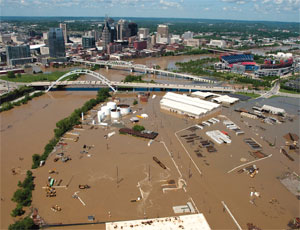Even as the rivers of Middle and West Tennessee are returning to their pre-flood levels, damage estimates are rising rapidly. Nashville Mayor Karl Dean (D) on May 11 raised the damage estimate for the city to $1.56 billion, with 99% of the private sector having been inspected. Absent from the total are public buildings and infrastructure damaged by torrential rain that fell on May 1 and 2.

David Penn, director of the Business and Economic Research Center at Middle Tennessee State University, Murfreesboro, expects the final tally be closer to $2 billion. “I don’t know if we’ll ever know, since so many losses are not insured,” he says. Across the state, officials say it’s too soon to tell.
Visitors’ Log
Federal disaster declarations were issued for 42 of the 52 counties affected. Before the floodwaters went down, Federal Emergency Management Agency officials started arriving, followed by the secretaries of Homeland Security, Housing and Urban Development, and Commerce.
“We’re very pleased with the pace of recovery operations, but we aren’t letting up,” Gov. Phil Bredesen (D) said on May 10.
Almost 18,000 individuals had registered with FEMA, 4,400 had inspections, and 14,000 had inspections scheduled. Thousands of volunteers came to help the flooded residents remove furnishings, carpet, drywall and debris and haul them out to the street.
Nashville hired Storm Reconstruction Services Inc. and the DRC Group, both of Mobile, to assist public-works department crews with debris removal.
Nashville remains under mandatory water-use restrictions after one of its two drinking-water plants was underwater after 13.5 inches of rain fell in about 36 hours. The deluge, unprecedented since records have been kept, exceeded the Cumberland River’s ability to drain water fast enough to prevent it from overflowing its banks.
Monday was the first day Scott Potter, Nashville Metro Water director, would not even offer an estimate on the drinking water plant restart, saying only “sometime next week.” Metro Water currently is draining the 9-million-gal clear well, replacing electrical and computerized monitoring systems, and repairing or replacing pumps and motors.
Interstates and most major roads had re-opened by May 10, although there were still some flood-related closures.
The Tennessee Dept. of Transportation let 10 contracts, totaling $13.8 million, for emergency bridge and highway repair. The agency estimates that $20 million will be needed.
CSX Corp. shut down its Nashville-Memphis line after two bridges were destroyed and three others damaged.
Most of the non-residential damage is to systems, not structures, says Stan Hardaway, president of the local Hardaway Construction Corp.
“All these buildings are steel or concrete frames,” he says. “They would have to be underwater for some time” to sustain structural damage.
Keep On the Sunny Side
Gaylord Opryland Resort and the Gaylord-owned Grand Ole Opry House, both major visitor attractions, flooded when the Cumberland River overflowed. About 800,000 sq ft of the 4-million-sq-ft hotel was flooded, with as much as 10 ft of water in some places.
However, only 177 of the 2,881 rooms were damaged. Gaylord brought in Marathon Flood Restoration, Milwaukee, and BMS CAT, Fort Worth, Texas, to dry out the buildings. “We can have the hotel functioning before year-end in some shape or form,” Colin Reed, Gaylord chairman and CEO, says.
Most of the damage was in the powerhouse, which Reed calls “critical” to re-opening. The nearby Opry Mills, a 1.2-million-sq-ft shopping mall, also was underwater.


Post a comment to this article
Report Abusive Comment